10. TRAJE DE FLAMENCA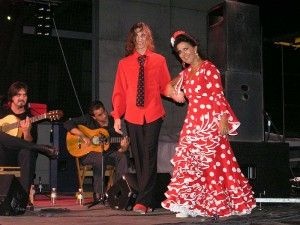
This type of costume called the Traje de Flamenca is worn by the Flamenco dancers in Spain during their dance performances and shows. The costume is beautifully decorated, both in plain or polka dots, and usually in bright colours such as red or yellow, or even blue. The dress is long enough to reach till the knees. The striking part of this outfit is that they are added up with ruffles on the skirt and sleeves of the dress. They can either be worn as a dress or separately in a top and skirt. When adorned, they give the dancers a pretty ruffled up look on their dresses, which makes the flamencos dance performances even charismatic and charming.
9. MUUMUU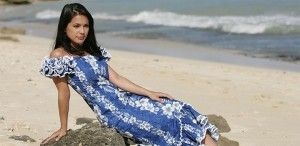
Thanks to the Hawaiian name, this loose long dress traces its existence back to the Hawaii origins. It is considered as a formal wear of clothing as the Muumuu is worn during occasional parties and other festivals and weddings. This outfit is also adorned for its classy look by women working in the hotel industry as well. This dress is loose and the sleeves of which hang a little loosely from the shoulders.
8. POLLERAS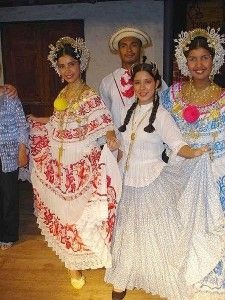
A Pollera is a Spanish outfit worn by the Spanish Latin Americans. This Spanish outfit dates it existence back to the 16th and the 17th century when they were a form of a major and popular Spanish colonial dress. Polleras are big one piece skirts, popularly worn during traditional festivals and events. They are made of different kind and types of materials, but the most popular type of polleras are the silk and the cotton ones. They are beautifully embroidered and crafted with animal and flower designs and represent a prime part of folk culture of the Spanish people.
7. BAJU KURUNG
The Baju Kurung is a traditional Malay dress and is the national dress for Brunei and Malaysia. The popularity of this tradition outfit is dated back to the 1970’s and 1980’s when the Islmisation of Malaysia took place. This dress came to popular adorned out of respect at all festivals and traditional occasions. This outfit is also seen worn at traditional events in Singapore and Thailand, where a lot of ethnic Malays reside. It is known as the ‘enclosed dress’ because of its closed structure and the loosely stitched outlook which covers the complete body.
6. KIMONO
The Kimono originally belongs to Japan and worn by the Japanese during any traditional or cultural events and on weddings. They are long T- shaped robes which cover the complete body and have wide and long sleeves to both the sides. They are available in all vibrant colours and also available in plain white and black colours. The Kimono is most widely worn by Japanese women but is also worn by some men during weddings and tea ceremonies in Japan. It looks equally pleasing on both Japanese men and women and is an important part of their culture and tradition during formal occasions.
5. AO DAI
The Ao Dai is a Vietnamese costume worn mostly by the women in the country. It is the national costume of Vietnam and is adorned by women on every special traditional and formal accession. It is a tight outfit made of complete silk material. It represent the Vietnamese feminine beauty in a great way and is an important part of Vietnamese culture. The word ‘Ao’ represents the upper part of the outfit where Dai means ‘long’
4. SARI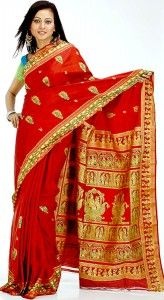
The Sari is a traditional women’s attire which is usually four to nine yards long in length. It basically means a piece of cloth draped over the body in different styles and ways. Saris are worn by women in many countries such as India, Pakistan, Malaysia, Nepal, Sri Lanka, and Burma. This traditional costume is worn over a petticoat and a blouse stitched in either full or half sleeves. They are made in different types of materials such as cotton, silk, chiffon, and are decorated with different types of vibrant colours and designs.
3. TRICANA POVEIRA
The Tricana Poveira traditional outfit arises from the Portugese city of Povoa de Varzim. It is a sign of traditional culture and fashion in the Portuguese cities and the women adoring this type of costume are popularly known as the Tricana girls. The Tricana Poveira initially started to be considered to be a mainstream source of fashion and style. But with time as people started getting accustomed to new styles and fashion tastes, the Tricana Poveira now is only seen worn by women during folk and traditional events and during parades and international events.
2. DIRNDL
A Dirndl is a skirt which is cut in a slightly circular way and reaches below the knees. Dirndl skirts are usually women by women of Germany, Austria, Switzerland and Liechtenstein. This type of outfit comprises of a long skirt, shirt, bodice and an apron. This was typically the type of costume for Alpine peasants in the olden days. Dirndls can be very expensive due to their popularity and exclusivity of make and design. They look very plain and simple, yet the type of materials used in making them are expensive such as silk and other hand printed fabrics. During winters, the demand of dirndls increases and thus one can see very dark and toned up coloured dirndls on sale. They are made of warm materials such as velvet, wool, thick cotton and linen. They are made heavy so as to provide warmth to the body. Surprisingly, the Dirndl initially began by being worn as an uniform by the Austrian servants in the 19th century, after which some high-class Austrian populace adopted it as a high fashion garment later.
1. CHEONGSAM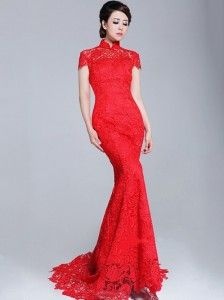
Also known as the Mandarin gown, this type of outfit is popular among Chinese men and women. The Cheongsam is worn by the Chinese women and Changshan is worn by the Chinese men. It is a body hugging one piece gown which goes down as long till the toes. It was created in the 1920’s in the city of Shanghai and then later was adopted as a popular style and fashion statement by the middle class and high class Chinese population. It started being worn by socialites and style icons and today is considered to be the traditional costume of China.



